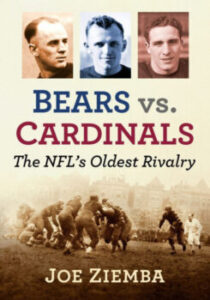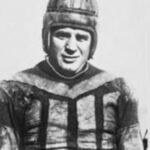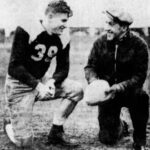In the long, long history of the National Football League, one rivalry usually grabs your interest immediately: the Bears and the Packers! Some even think that it is the oldest rivalry in the league and we’ll talk about that in a moment as well. The Bears vs. Packer history runs deep.
However, the focus of this program will be to drift back to 1921 when the two teams first met on the gridiron. Some familiar names were already in place with Curly Lambeau leading the Packers and George Halas fronting the squad then known as the Decatur Staleys. Halas had recently worked out an agreement in October of 1921 with owner A.E. Staley where Halas would take over the operation of the club and move its home games from Decatur, IL to Chicago. As part of this agreement, the team would play under the name of the Staleys for the remainder of the 1921 campaign. In 1922, Halas would officially change the name of his team to the Chicago Bears.
The inclusion of tiny Green Bay into membership in the NFL was not unusual in the early 1920s. Many smaller towns and cities such as Hammond, IN, Canton, OH, and Rock Island, IL were also members of the league during that time. Green Bay, however, is the only representative from the smaller communities that has survived to this day in the NFL. Through solid community support, an innovative method of financing the team, and eventual league television revenue sharing, the Packers remained viable in the NFL over the last century.
The "Spirit" of Green Bay Packer Fans
In 1921, the citizens of Green Bay were justifiably proud of the “spirit” of their team and were all-in when supporting the organization from tremendous local coverage by the Green Bay Gazette newspaper to the hundreds of rabid followers that traveled with the football team to its faraway Sunday games. The population of Green Bay in 1920 was just 31,643 (and is still just a bit over 106,000 today), but the fans of the Packers were boundless in their enthusiasm for their team when it entered the league in 1921. The city of Chicago was the first to experience this unusual “spirit” of the Packers’ fans.
After playing their first eight games at home, losing only a 13-3 battle to the Rock Island Independents, the Packers were 7-1 and overjoyed to receive their invitations to visit Chicago and engage the Cardinals and the Staleys on successive weekends in late November of 1921. At the time, Chicago’s population hovered around 2.7 million (similar to today) so the upcoming match-ups would truly fit the David vs. Goliath scenario.
The Green Bay Gazette admitted as such by stating: “Green Bay is the smallest city in the circuit and it is the Packers’ first year in the big game.” The Cardinals and Green Bay met first—on November 20, 1921, at Normal Park in Chicago when the teams battled to a 3-3 tie. Two future Hall-of-Famers, Curly Lambeau of the Packers, and Paddy Driscoll of the Cardinals kicked field goals for their respective clubs. For some reason, there was a bit more excitement surrounding the Packers’ game with the Staleys scheduled for the following Sunday, November 27. While the arrangements for both games were similar, we’ll examine the preparations in Green Bay for the Staleys’ contest.
Bears vs Packers History: Fans Getting Started
First of all, the tie with the Cardinals did a tremendous amount to boost the confidence of the Packers and their loyal fandom. Although working in the league’s smallest city, Lambeau had done an excellent job of attracting top-flight players from around the Midwest, including five former Notre Dame players where Lambeau himself had once spent a season. In other words, the Packers were ready for the big, bad Staleys and the Gazette confidently predicted a competitive battle: “Sunday, the Packers squad plays its most important game of the year at Cubs Park, Chicago against the Decatur Staleys, who are one of the strongest professional elevens in the pigskin chasing wheel. A win for the Packers will give Green Bay a claim on the championship of the country.”
The Packers prepared for the game by arriving in town early and practicing twice daily at Loyola University near Cubs Park while the Gazette hammered away at the growing migration planned for the trip to the windy city in an article published on the Friday before the game: “Interest over the game is warming up. ‘On to Chicago’ appears to be the slogan of the football fans in this neck of the woods and when the whistle blows on Sunday at least 500 rooters are expected to be in the Packers’ section.”
Special coach cars on the train to Chicago for Green Bay were filling up fast with a reduced round-trip fare of $9.69. The entire group of several hundred would be housed at the Stratford Hotel in Chicago. In addition, a 20-piece band was secured to accompany the team and the Gazette reported that “An appeal was sent out to fans to make it possible for the band to accompany the team, by making contributions. The response was prompt and several donations ranging in size from one to ten dollars have come in.” Even Curly Lambeau joined in the pre-game frenzy by stating:
“We’ll beat them. After giving the Staleys the once over, I feel confident that the Packers will be champions of the middle west Sunday night. Come on down fans and let’s show Chicago that Green Bay is the best little football town in the country!”
Now, if fans were unable to follow Curly’s advice and attend the game in Chicago, there was another helpful way for the locals to follow the game as well as to raise some money. As it had been done for the Cardinals’ game a week before, seats were being sold in Green Bay’s Turner Hall where the results of each play in Chicago would be telegraphed back to Wisconsin and then relayed to the anxious audience. The Gazette barked out this warning to its readers:
Heads up football fans! If you want to get your seats for the wire contest which will be held at Turner Hall reporting the American Professional Football League game…get ‘em early or you won’t be able to get in!
The Green Bay Gazette explained how this high-tech innovation worked: “Each play will be given off the wire by downs and although the players can’t be seen in action, a little use of the imagination will probably add more excitement than if one were present at the game itself. Mulligan Scroogy will handle the megaphone and his amusing antics ought to be a big attraction of the afternoon game.”
Apparently, Mulligan Scroogy had done such a great job calling out the plays during the Cardinals game the week before when the system was first used, that additional information would be forthcoming during the Staleys’ clash, according to the Gazette: “Aside from the actual story of the game play by play, interesting side lights and features will be given to the spectators covering the complete goings-on at Cubs Park.”
Arriving For The Big Game
Upon arriving in Chicago for the big game after the approximately 200-mile rail journey, the multitude of Packers’ fans, and their vivacious 20-piece band decided to capture the streets of Chicago as reported by the Gazette:
Staid old Chicago got a new thrill on Sunday and the college authorities who claim that “There ain’t no such thing as ‘spirit’ in professional football” stood back and gasped as the rooters from Green Bay, Wisconsin took the town by storm Sunday morning and held full sway until the last car of the special excursion pulled out from the Northwestern about three bells Monday morning. Headed by a ‘lumberjack’ band of twenty pieces, some five hundred fans from the Wisconsin town invaded Chicago for the game between the Packers and Staleys for the mid-west championship. The Badgers started whooping things up from the minute they arrived!”
But there’s more: “Despite the fact that parades are barred in Chicago unless a permit is secured, the Bay rooters trailed up the street from the depot to the Stratford Hotel and let everyone know who they were and why they were here.” A couple of weeks later, an article in the Rock Island Argus described the unusual sight of the Packers’ fans as they paraded through the streets of Chicago: “With them came their famous band, every man clad in a loggers’ costume, and none alike. Bright-colored mackinaw coats, heavy woolen stockings, boots, corduroy trousers, and so forth—and they knew all sorts of music from classical down to the jazzy sort. Green Bay takes it pro eleven like Princeton does its Tigers.”
Bears vs Packer History: The First Outcome
Unfortunately, the mayhem shared by the Packers’ fans did not translate to the gridiron as the Staleys cruised to an easy 20-0 win over the visitors. Touchdowns by Pete Stinchcomb, Pard Pearce, and George Halas himself paved the way to the victory. Even in defeat, the Gazette was proud of its team stating: “The Packers were beaten but not disgraced. Every man on the team played great football. They were there in the battling every minute and when the final whistle blew there was plenty of glory in the defeat.”
While we may never again see the spirit of the early Packers’ fans as they were in 1921, the contest did seem to be the first to truly prove that the game of pro football had a pulse, that it was not simply played for quick money and forgotten loyalties. And what about that rivalry? Is the Bears-Packers match-up the oldest in NFL history? Not really. Although the two teams are still playing every year, the oldest rivalry in the NFL began with the Bears and Cardinals on November 28, 1920, followed by the Cardinals and the Packers’ first encounter on November 20, 1921. The Bears and the Packers, as just described, met for their initial meeting on November 27, 1921, making it the third-oldest rivalry in the league.
As we wrap up today’s episode, we’ll look back one last time at the “spirit” that Green Bay brought to the NFL in 1921 and how it may have changed the general public’s perception of professional football. After that first Staleys-Green Bay game in 1921, Chicago sportswriter Ed Smith wrote the following about the Packers and their fans: “If there was more of this kind of spirit shown in professional football the game would jump to the front with a rush. I take my hat off to Green Bay. It was splendid!”
And so, it was almost 100 years ago when guys with great names like Curly Lambeau and Mulligan Scroogy helped make the world aware of the Green Bay Packers, a tradition of spirit that the Green Bay faithful continue today. Thank you for sharing part of your day with us on the Sports History Network and please join us next time for a look at the career of Hall of Famer Ollie Matson, who won two Olympic medals and was once traded by the Chicago Cardinals for nine players!
Joe Ziemba is the host of this show, and he is an author of early football history in the city of Chicago.
Here, you can learn more about Joe and When Football Was Football, including all of the episodes of the podcast.
Please Note – As an Amazon Associate I earn from qualifying purchases
Resources
More From When Football Was Football
Paddy Driscoll’s Almost Perfect Season
Back at the beginning of the National Football League in...
Read More120,000 Fans Witness High School Football Game in 1937!!!
Let’s set the stage… It was a warm November afternoon...
Read MoreIn The Beginning: An Interview With Joseph T. Sternaman
And, you may ask, who is Joseph T. Sternaman? Sternaman...
Read More1948: The Last Hurrah of the Chicago Cardinals
Cardinals’ fans are familiar with the long, sad story concerning...
Read More



